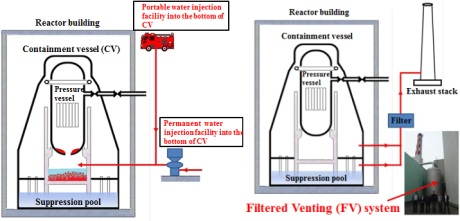Japan's new nuclear regulations could demand that operators are prepared to avoid an accident even in the case of war or deliberate aircraft impact. Draft rules are at the first public comment stage.
The Fukushima accident of March 2011 showed that neither the Japanese government, regulator or industry had taken enough care to prepare for severe accident situations. Part of the response has been to create a new safety body, the Nuclear Regulatory Authority, which is now in the process of drawing up operating requirements before it will allow any reactors to come back online. At present, all but two units remain shut down, awaiting permission to restart and continue generating electricity.
The philosophy of regulation has been expanded to include the assumption of large scale natural disasters, such as seen in March 2011. But in addition come requirements to prepare for 'terrorism and war', according to an NRA presentation. The body applies what it called an 'exhaustive defence in depth concept' in which multiple safety systems would work independently of each other to avoid accidents.
First come measures to protect the plant from external risk, including stronger and higher tsunami walls and waterproofing of key buildings on site. More cautious earthquake analysis will look further back in time when determining if a fault is active - at least the last 120,000 years but perhaps as far as 400,000 years.
Countermeasures
After those are additional countermeasures to prevent damage to reactor cores, including mobile power generators, secure sources of make-up water and methods to inject water. These should be enough to prevent accidents.
The NRA then goes further with requirements to eliminate many issues that exacerbated the situation for Tepco in 2011. During the station black-out at Fukushima Daiichi Tepco struggled to open powered valves that could have depressurized the reactor and helped it inject water early enough to avoid core damage. These valves may be required to have manual opening procedures to avoid such a problem occurring again.
Assuming all of the above have failed and the plant is in a core-melt situation, operators should have sufficient countermeasures to cool and depressurise the containment, protect its integrity and keep radioactive materials confined. Filtered venting procedures are specified here.
If melted nuclear fuel were to exit the reactor vessel, operators should have a water injection system to cool the highly radioactive and heat-generating debris in the area beneath the vessel. Some new reactor designs feature such a purpose built 'core catcher', but Japanese units would have to retrofit a suitable analogue.
 |
| Two of NRA's countermeasure ideas during a severe accident. Left, a water injection system cools damaged fuel beneath the reactor vessel. Right, a filtered venting system allows depressurisation without undue release of radioactive material |
Among the most disruptive features of the Fukushima accident were the hydrogen explosions that wrecked the buildings and allowed the escape of radioactive matter. These could have been avoided by the use of hydrogen recombiners to remove the explosive gas. The Fukushima Daiichi units had these units inside the containment vessel, but they required power and so were useless during the station black-out, and there were none in the reactor building where the explosions went on to occur. In future, Japanese power plants may all feature passive versions that do not need power both inside containment and in the reactor buildings. Many plants are already in the process of fitting these.
Turning its attention to potential terrorist attacks, the NRA has drafted that operators will need a secondary control room and sources of power and water perhaps 100 metres from the reactor building. This is to allow the remote control of the power plant in scenarios such as the deliberate crash of an aircraft that could cause large fires and physical damage on site.
Lastly comes a flexible response to radioactive releases. NRA wants operators to have available water cannon to spray foam or water to stop and trap radioactive material at the point of release to avoid wide dispersion and aid clean-up.
Drafting process
The recommendations above result from consideration of international standards and feedback from nuclear plant operators. They are now open for a period of public comment. There will be a further drafting step and a final public comment before enaction in law in July.
The NRA has previously said that utilities will be able to apply for inspections and approval prior to July, although it would not give its final opinion until after the final requirements had been legislated.
Researched and written
by World Nuclear News




_18570.jpg)
_16159.jpg)
_18938.jpg)
_33584.jpg)





